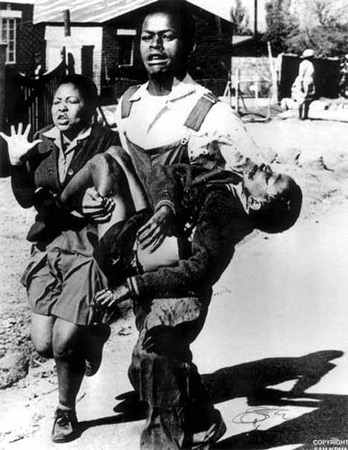 For a time during apartheid, Black schools taught in English and one of nine Bantu languages. Parents chose which Bantu language they wanted their child to learn. In 1974, the National Party issued the Afrikaans Medium Decree, which marginalized the Bantu influence in the schools by forcing all black schools to conduct their instruction in Afrikaans and English, 50-50. The indigenous languages could only be used for religious studies, music, and PE. The blacks resented the decree strongly, viewing Afrikaans as the language of their oppressors. To them, this was the final straw, the "cherry on top" of a host of racist policies, underfunding, and mistreatment in the black educational system.
For a time during apartheid, Black schools taught in English and one of nine Bantu languages. Parents chose which Bantu language they wanted their child to learn. In 1974, the National Party issued the Afrikaans Medium Decree, which marginalized the Bantu influence in the schools by forcing all black schools to conduct their instruction in Afrikaans and English, 50-50. The indigenous languages could only be used for religious studies, music, and PE. The blacks resented the decree strongly, viewing Afrikaans as the language of their oppressors. To them, this was the final straw, the "cherry on top" of a host of racist policies, underfunding, and mistreatment in the black educational system.By 1976, the tension had reached a fever pitch. The students of Orlando West High School drafted and signed a memorandum indicating they would refuse to come to school if Afrikaans was to be implemented according to the 1974 decree. On June 16, they boycotted school en masse and began marching the memorandum to the police station, more than two miles away. Here is a photograph of their march...Alan was one of these kids...
 Before the students could get to the police station, the Army started dropping teargas and sending in anti-riot vehicles. Students threw rocks at police. The police responded with gunfire. According to Alan, all hell broke loose and everybody started scrambling. In the melee, a 13-year-old boy named Hector Pieterson was killed by a policeman's bullet...
Before the students could get to the police station, the Army started dropping teargas and sending in anti-riot vehicles. Students threw rocks at police. The police responded with gunfire. According to Alan, all hell broke loose and everybody started scrambling. In the melee, a 13-year-old boy named Hector Pieterson was killed by a policeman's bullet... The iconic photo of Mbuyisa Makhubu carrying Hector Pieterson's lifeless body was transmitted around the world and served as a visual symbol of the apartheid regime's cruelty. The event served as a key turning point in the struggle against apartheid. Until that time, the struggle had been fought by ANC leaders in exile in the neighboring countries of Rhodesia, South West Africa, and Angola. After June 16, the insurgency became internal as well, forcing the ruling regime to fight it on two fronts. Never again was the state able to attain the peace and stability of the early 70's. The U.N. issued a resolution condemning the apartheid regime, and international activism had a rallying cry. Twenty years later, the BBC went so far as to title a documentary, "The Day Apartheid Died." (More at Wikipedia.)
The iconic photo of Mbuyisa Makhubu carrying Hector Pieterson's lifeless body was transmitted around the world and served as a visual symbol of the apartheid regime's cruelty. The event served as a key turning point in the struggle against apartheid. Until that time, the struggle had been fought by ANC leaders in exile in the neighboring countries of Rhodesia, South West Africa, and Angola. After June 16, the insurgency became internal as well, forcing the ruling regime to fight it on two fronts. Never again was the state able to attain the peace and stability of the early 70's. The U.N. issued a resolution condemning the apartheid regime, and international activism had a rallying cry. Twenty years later, the BBC went so far as to title a documentary, "The Day Apartheid Died." (More at Wikipedia.)As for Alan, with the blessing of his parents, he risked his life to escape the chaos in Orlando and headed to another city 400km away to live with relatives until the violence dissipated enough for him to return.
 Today, the area where Hector Pieterson lost his life has been turned into a first-class memorial and three-story multimedia historical museum. As befits its historical significance, it is by far the nicest block in Soweto, as far as we could tell. The courtyard out front has a fountain heading down the hill towards the police station in the distance, with stone inscriptions and photographs of the event.
Today, the area where Hector Pieterson lost his life has been turned into a first-class memorial and three-story multimedia historical museum. As befits its historical significance, it is by far the nicest block in Soweto, as far as we could tell. The courtyard out front has a fountain heading down the hill towards the police station in the distance, with stone inscriptions and photographs of the event. Bill and I found it remarkable that, in the space of 48 hours, we had met a participant in the student uprising (Alan) and a member of the apartheid regime's Citizens' Active Force (Sinterklaas). We got first-hand accounts of both extremes of the recent history of South Africa. Wow.
Bill and I found it remarkable that, in the space of 48 hours, we had met a participant in the student uprising (Alan) and a member of the apartheid regime's Citizens' Active Force (Sinterklaas). We got first-hand accounts of both extremes of the recent history of South Africa. Wow.
No comments:
Post a Comment